| Koshidaka HOLDINGS Co., Ltd. (2157) |
|
||||||||
Company |
Koshidaka HOLDINGS Co., Ltd. |
||
Code No. |
2157 |
||
Exchange |
First Section, Tokyo Stock Exchange |
||
Industry |
Service |
||
President |
Hiroshi Koshidaka |
||
HQ Address |
World Trade Center Building 23rd Floor, 2-4-1 Hamamatsucho, Minato-ku, Tokyo |
||
Year-end |
August |
||
URL |
|||
* Share price as of close on October 23, 2017. Outstanding shares as of most recent quarter end, excluding treasury stock. ROE and BPS are actual results from the previous term.
|
||||||||||||||||||||||||
|
|
* Estimates are those of the company. From fiscal year August 2016, the definition of net profit has been changed to net profit attributable to parent company shareholders. (The same shall apply hereinafter.)
* A two for one stock split was conducted in September 2014. (EPS has been adjusted from fiscal year August 2014.) This Bridge Report presents an overview of Koshidaka HOLDINGS's earnings results for fiscal year August 2017 and earnings estimates .for fiscal year August 2018. |
|
| Key Points |
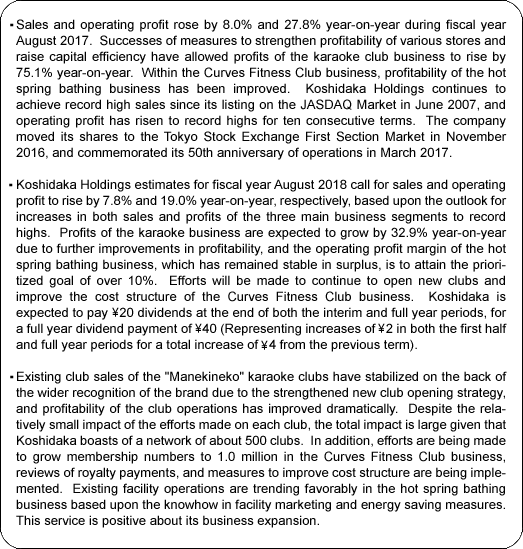 |
| Company Overview |
|
<Corporate Philosophy - Contribute to the Creation of a Peaceful World by Providing Bountiful Hope and Lifestyles Rich with Entertainment>
Koshidaka maintains a corporate philosophy of "contributing to the creation of a peaceful world by providing bountiful hope and lifestyles rich with entertainment, while continuing to provide evolutionary and significant services and products to people worldwide." Based upon this corporate philosophy, Koshidaka has also established five visions: 1) cultivating new businesses in existing industries to provide easily accessible entertainment that only requires short amount of time, and is close and reasonable, 2) developing optimized businesses and structures based upon conditions in each country, area, and industry, 3) continuing to offer surprising and highly satisfying services and products with customers' needs in mind, 4) fostering inspired and entrepreneurial human resources, and 5) seeking to cultivate and maximize synergies between the various businesses of the group.
 <Business Segments and Group Structure>
The Koshidaka HOLDINGS Group currently divides its business into four main segments: karaoke, Curves Fitness Club, hot spring and real estate management businesses. In the karaoke business segment, the company operates both the "Karaoke Honpo Manekineko" clubs and "One Kara" individual use karaoke clubs. In the Curves Fitness Club business, fitness clubs providing 30 minute workout programs specialized for middle to older aged female users called "Curves" are operated. Furthermore, the hot spring business (Leveraging various hot spring facility operation knowhow), and real estate management businesses are also being undertaken. The Koshidaka Group is comprised of the holding company Koshidaka HOLDINGS, along with nine consolidated and three non-consolidated subsidiaries.
 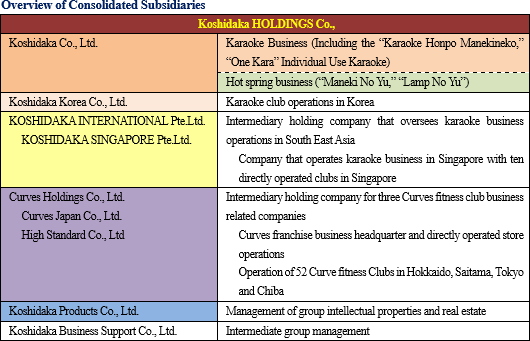 <Growth Strategy>
The possibilities within the Japanese leisure related market are considered to be limitless, given the massive market size of about ¥72.3 trillion (Source: Japan Productivity Center, Leisure White Paper 2016). Moreover, an increase in the number of baby boomers approaching the age of 75 (Peak number being born between 1947 to 1949) is expected to contribute to strong growth in the market. Based upon the business concept of becoming a "comprehensive leisure services company," Koshidaka seeks to cultivate synergies between the four realms of "amusement (karaoke)," "sports and fitness (Curves)," "tourism and travel (hot springs)," and "hobbies and cultural activities" to promote a strategy of "creating new businesses in existing industries." Koshidaka also maintains a goal of achieving group sales of ¥100.0 billion at an early stage.
 |
| Fiscal Year August 2017 Earnings Results |
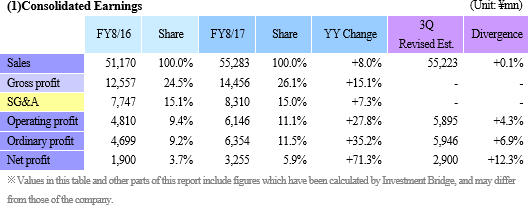 Sales and Operating Profit Rise by 8.0% and 27.8% Year-On-Year, Respectively
Sales rose by 8.0% year-on-year to ¥55.283 billion on the back of a 7.1% year-on-year increase in sales of the karaoke club business derived from new club openings, and a 9.5% year-on-year growth in sales of the Curves Fitness Club business due to growth in new club openings, memberships and goods sales. Despite a lack of new facility openings, sales of the hot spring bathing business rose by 5.5% year-on-year.Operating profit rose by 27.8% year-on-year to ¥6.146 billion due to improvements in karaoke club operations through increases in capital equipment ratio, which resulted in a 1.6% point improvement in gross profit margin to 26.1%. Growth in the karaoke club business facility numbers helped to absorb increases in sales, general and administrative expenses. Non-operating income improved due to the booking of foreign exchange translation gains and facility move subsidies, and the disappearance of foreign exchange translation loss (¥79, ¥73 and ¥177 million respectively). Despite an increase in extraordinary losses from ¥166 to ¥662 million arising from the impairment loss of ¥0.3 million on the "SuKITo" (Smart Karaoke Internet Terminal), and asset retirement and impairment losses of ¥0.3 million arising from the move and closure of clubs within the karaoke club business. At the same time, the influence of tax effect accounting implementation allowed net profit to rise by 71.3% year-on-year to ¥3.255 billion. 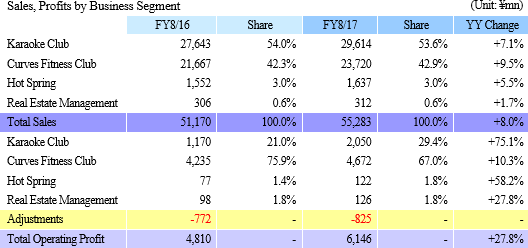 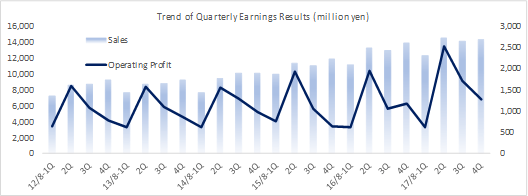  Existing club sales stood at 98.4% of the previous year. However, the wider recognition of the "Manekineko" brand is contributing to favorable existing club sales trends in the Tokyo and surrounding regions and also to profits. Within Japan, sales of existing clubs (down ¥468 million) and overseas both declined. However, the contributions from newly opened clubs within Japan (¥2.602 billion) absorbed these declines and allowed overall sales to rise by 7.1% year-on-year to ¥29.614 from ¥1.970 billion in the previous term. Improvements in capital equipment ratio and club operations efficiencies allowed gross profit margin to rise by 2.3 points to 20.8%. At the same time, the restrained growth in sales, general and administrative expenses of 3.9% year-on-year allowed business segment operating profit to rise by 75.1% to ¥880 million. Club operation efficiency has been improved by implementing measures based upon management data to optimize operating hours, time of day based fee schedules, and club staff assignments. Within operating expenses, labor, rent, and depreciation rose (by ¥399, ¥376 and ¥146 million, respectively), but improvements in capital equipment ratio allowed the ratio of labor to sales to decline from 27.2% to 26.7%. Optimization of advertising activities allowed advertising expenses to decline by ¥124 million.    Increases in goods sales to members of ¥1.177 billion and royalty income of ¥736 million offset a decline in spot sales of ¥52 million from club franchisees arising from a fall in the number of clubs, and allowed sales to rise by 9.5% year-on-year to ¥23.720 billion. Higher sales of goods which carry relatively high gross profit margins, allowed gross profit margin to improve and helped to absorb increases in sales, general and administrative expenses. Segment operating profit rose by 10.3% to ¥4.672 billion.    (3) Financial Position and Cash Flow
Total assets rose by ¥10.172 billion from the end of the previous term to ¥43.690 billion at the end of the current term. The procurement of ¥4.586 billion through a public offering of 1 million shares and liquidation of 1 million of its treasury stock (issuance and liquidation price of ¥2,392) on May 24, 2017, and improved cash flow allowed cash and deposits to rise, along with increases in tangible noncurrent assets due to new club openings. Interest bearing liabilities (interest bearing liabilities excluding leases: fall from ¥9.820 to ¥9.737 billion) declined, while net assets rose. Capital adequacy ratio improved by 9.2 points from 40.4% at the end of the previous term to 49.6% at the end of the current term.With regard to cash flow, increases in net profit, and optimization of capital efficiency in the karaoke club business allowed operating cash flow to grow by a large margin. Also, the issuance of shares and liquidation of treasury stock allowed financing cash flow to also increase by a large margin. 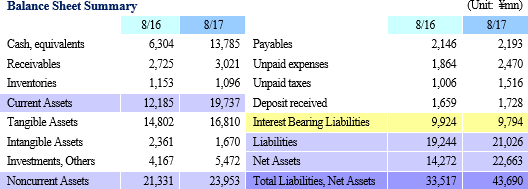  |
| Fiscal Year August 2018 Earnings Estimates |
 Estimates Call for Sales and Operating Profit to Rise by 7.8% and 19.0% Year-On-Year, Repectively
Koshidaka Holdings anticipates both sales and profits of all three of its business segments to grow, and its total sales and profits to rise to another year of record highs in the coming term. Increases in sales and improvements in capital equipment ratio of the karaoke club business are expected to allow profitability to improve a step further and allow operating profit to grow by 32.9% year-on-year. While sales of the hot springs bathing business, which has turned profitable, are expected to grow marginally, Koshidaka maintains a short term target for operating profit margin of over 10%. With a goal of boosting membership number to 1.0 million, Koshidaka will fortify its services and club network in its Curves Fitness Club business. In addition, other measures to improve profitability including reviews of royalty payments and reforms of the cost structure will also be implemented.
(2) Strategies by Business Segment
Koshidaka plans to open 45 new clubs in the Tokyo and surrounding three prefectures (25 newly constructed, 20 acquired from other operators) as part of its facility network strengthening strategy within the karaoke club business. In addition, efforts will be made to further raise the capital equipment ratio including introduction of "Maneki Pad" tablet terminals and automated cash registers to improve efficiency.With regard to sales, artificial intelligence and Internet of Things will be introduced, efforts will be made to develop new services, and new contents using artificial intelligence will be introduced. In overseas markets, efforts to strengthen profitability in Singapore and Korea are being promoted, and new business opportunities in Southeast Asia (Indonesia, Vietnam and Philippines) are being considered. Koshidaka is considering potential business partnerships with local businesses as a means of promoting its business in these new regions. In the Curves Fitness Club business, the company maintains plans to open 85 new clubs and strengthen its services to boost membership numbers to 1.0 million. The fortification of services is specifically designed to maintain the current low withdrawal rates, and new club locations will be carefully considered to eliminate the potential for cannibalization with existing clubs. In addition, Koshidaka is also jointly promoting awareness activities to raise the public awareness of the benefits of exercise along with local government bodies as a company that provides solutions to various social issues. Also, efforts to review royalties paid to the franchising headquarter in the United States and other measures to improve the cost structure are being promoted. 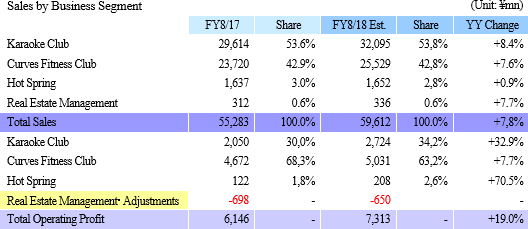 (3) Returns to Shareholders: Dividends Raised Every Year Over 10 Year Period Since Listing
Koshidaka is expected to pay ¥20 per share dividends at the ends of both the first half and full year for a total dividend payment of ¥40 per share. This represents ¥2 yen increases in the first half and full year dividends over the previous term, and a ¥4 increase in the total dividend. As part of the shareholder benefit program, the company will also present shareholders with over 100 shares and registered as of August 31, 2017 with gift cards equivalent to ¥5,000, and offer shareholders with larger holdings with their choice of products from a gift catalog in accordance with the number of their shares. With regard to the gift catalog, shareholders with shares between 100 and 1,000, and over 1,000 will be able to select products from the gift catalog amounting to ¥3,000 and ¥5,000, respectively.
|
| Conclusions |
|
With regard to the Curves Fitness Club business, the potential for further new club openings is declining. However, Koshidaka expects to conduct negotiations for its royalty payments leading up to the renewal of its contract in the next three years due to the fact that the role of the franchising headquarter in the United States to instruct and support franchisees is diminishing. It may be worth mentioning that Japan has been the most successful operations for Curves Fitness Clubs globally, and the operations in the United States itself is actually encountering difficulties. While there were some fears about the future of the hot spring bathing business, success in marketing and energy conservation efforts have allowed existing facility sales to recover. Although more attention will need to be paid in the decision making process, Koshidaka is now considering the potential for opening new facilities and expanding this business further. |
| <Reference: Regarding Corporate Governance> |
 ◎ Corporate Governance Report
Updated on Dec. 1, 2016
Basic Policy
The basic policy for corporate governance of our corporate group is to achieve swift decision making and flexible organizational operation for strengthening our corporate competitiveness amid the rapidly changing business environment, while keeping the transparency and soundness of business administration for maximizing the corporate value with respect to shareholders, and we have developed systems and implemented some measures for it. The important mission in our business administration is to achieve sustainable growth and improve our medium and long-term corporate value. In order to fulfill this mission, our corporate group has fostered good relationships with all stakeholders, including shareholders and customers, while respecting their respective standpoints, and set our group's "management philosophy" and "behavioral standards" for following the philosophy.Corporate Mission Our mission is to contribute to the realization of lifestyles full of leisure and to the establishment of a peaceful world filled with hope by continuing to create, offer and provide the world with new and meaningful products and services. Behavioral Standards 1. Have a spirit of entrepreneurship 2. Have a "customers come first" mentality 3. Create new services 4. Refine our spirit of hospitality 5. Have a "morals before profit" mentality 6. Maintain equality and fairness 7. Maintain compliance 8. Maintain awareness of global environmental conservation 9. Encourage staff to educate themselves 10. Offer an abundance of opportunity <Disclosure Based on the Principles of the Corporate Governance Code (Excerpts)>
The basic policy of our company is not to hold shares strategically. In our company, important transactions with executives and major shareholders (transactions among parties concerned) are determined by the board of directors. For each account settlement, directors and major shareholders are obligated to submit a written confirmation about whether they have conducted any transactions among parties concerned. (Basic policy) Through constructive dialogue with shareholders, we will deepen their understanding of our company, achieve sustainable growth, and improve our medium and long-term corporate value. (Division in charge) If a shareholder requests a dialogue (meeting), the division in charge of IR will deal with the request. After confirming the purpose, etc. of the dialogue (meeting) of the shareholder, the management, including the executive in charge of the IR division, will hold a meeting, if necessary. (Means for dialogue other than individual meetings) In our company, directors disclose information regularly through results briefing sessions, etc. (Prevention of the leakage of insider information) As for the management of insider information, our company prevents the leakage of insider information by managing information rigorously in accordance with the in-company regulations for inside information management and the prevention of insider trading. Disclaimer
This report is intended solely for informational purposes, and is not intended as a solicitation to invest in the shares of this company. The information and opinions contained within this report are based on data made publicly available by the Company, and comes from sources that we judge to be reliable. However we cannot guarantee the accuracy or completeness of the data. This report is not a guarantee of the accuracy, completeness or validity of said information and or opinions, nor do we bear any responsibility for the same. All rights pertaining to this report belong to Investment Bridge Co., Ltd., which may change the contents thereof at any time without prior notice. All investment decisions are the responsibility of the individual and should be made only after proper consideration.Copyright(C) 2017, Investment Bridge Co., Ltd., All Rights Reserved. |



